Milwaukee 0522-20, 0521-20 User Manual
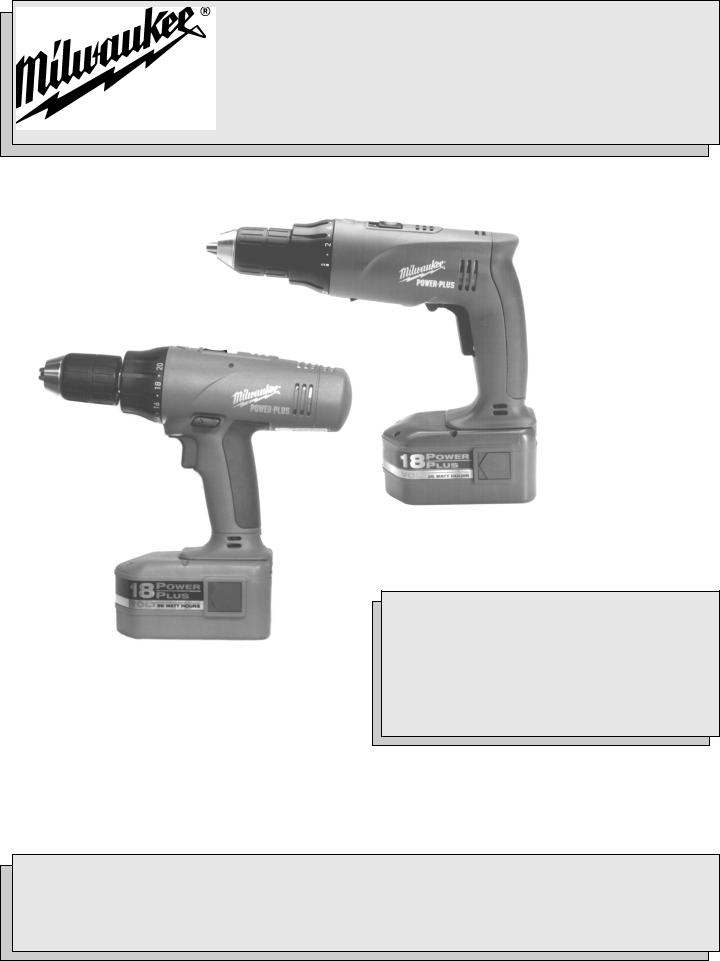
OPERATOR'S MANUAL
MANUEL de L'UTILISATEUR
MANUAL del OPERADOR
Catalog No. No de Cat.
Catálogo No.
0521-20
0522-20
SPECIAL NOTE: New battery packs are not fully charged. Charge your battery pack before using it for the first time and follow the charging instructions in your charger manual.
NOTE SPÉCIALE : Les batteries neuves ne sont pas entièrement chargées. Chargez la batterie avant de vous en servir la première fois en suivant les instructions de recharge dans le manuel qui accompagne cet outil.
NOTA ESPECIAL: Las baterías, cuando son nuevas, no están totalmente cargadas. Cargue su batería antes de usarla por primera vez y siga las instrucciones de carga que vienen en el manual de la herramienta.
18 V 1/2" HI-TORQUE HAMMER-DRILL
PERCEUSE-TOURNEVIS 18V 13 mm (1/2") SANS CORDON À COUPLE ÉLEVÉ TALADRO/ATORNILLADOR DE 18V DE 13 mm (1/2"), A BATERIAS, DE ALTO TORQUE
TO REDUCE THE RISK OF INJURY, USER MUST READ AND UNDERSTAND OPERATOR'S MANUAL.
AFIN DE RÉDUIRE LE RISQUE DE BLESSURES, L'UTILISATEUR DOIT LIRE ET BIEN COMPRENDRE LE MANUEL DE L'UTILISATEUR.
PARA REDUCIR EL RIESGO DE LESIONES, EL USUARIO DEBE LEER Y ENTENDER EL MANUAL DEL OPERADOR.
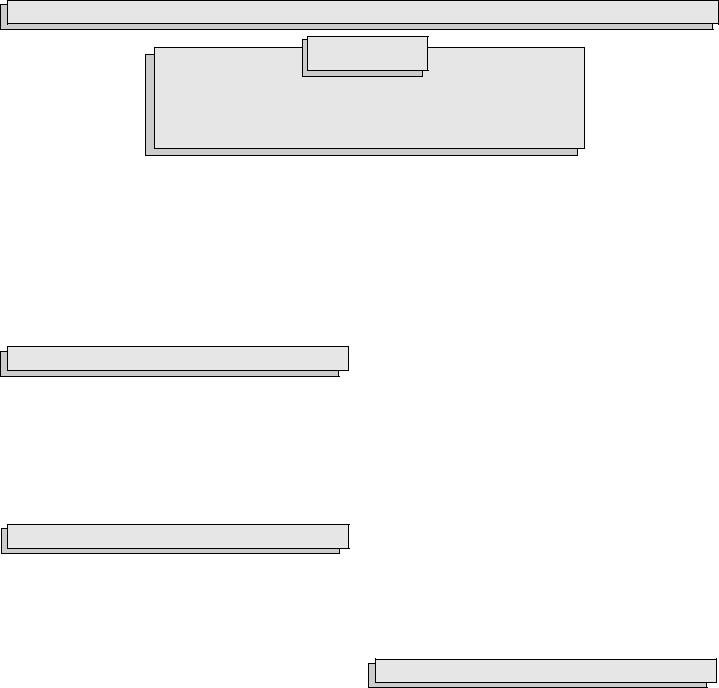
GENERAL SAFETY RULES — FOR ALL BATTERY OPERATED TOOLS
WARNING!
READ AND UNDERSTAND ALL INSTRUCTIONS.
Failure to follow all instructions listed below, may result in electric shock, fire and/or serious personal injury.
SAVE THESE INSTRUCTIONS
|
WORK AREA |
|
|
|
TOOL USE AND CARE |
|
|
|
|
|
|
||
|
|
|
|
|
|
|
|
|
|
|
|
|
|
1.Keep your work area clean and well lit. Cluttered benches and dark areas invite accidents.
2.Do not operate power tools in explosive atmospheres, such as in the presence of flammable liquids, gases, or dust. Power tools create sparks which may ignite the dust or fumes.
3.Keep bystanders, children, and visitors away while operating a power tool. Distractions can cause you to lose control. Protect others in the work area from debris such as chips and sparks. Provide barriers or shields as needed.
ELECTRICAL SAFETY
4.Do not abuse the cord. Never use the cord to carry the tool. Keep cord away from heat, oil, sharp edges, or moving parts. Replace damaged cords immediately. Damaged cords may create a fire.
5.A battery operated tool with integral batteries or a separate battery pack must be recharged only with the specified charger for the battery. A charger that may be suitable for one type of battery may create a risk of fire when used with another battery.
6.Use battery operated tool only with specifically designated battery pack. Use of any other batteries may create a risk of fire.
PERSONAL SAFETY
7.Stay alert, watch what you are doing, and use common sense when operating a power tool. Do not use tool while tired or under the influence of drugs, alcohol, or medication. A moment of inattention while operating power tools may result in serious personal injury.
8.Dress properly. Do not wear loose clothing or jewelry. Contain long hair. Keep your hair, clothing, and gloves away from moving parts. Loose clothes, jewelry, or long hair can be caught in moving parts.
9.Avoid accidental starting. Be sure switch is in the locked or off position before inserting battery pack. Carrying tools with your finger on the switch or inserting the battery pack into a tool with the switch on invites accidents.
10.Remove adjusting keys or wrenches before turning the tool on.
A wrench or a key that is left attached to a rotating part of the tool may result in personal injury.
11.Do not overreach. Keep proper footing and balance at all times.
Proper footing and balance enable better control of the tool in unexpected situations.
12.Use safety equipment. Always wear eye protection. Dust mask, non-skid safety shoes, hard hat, or hearing protection must be used for appropriate conditions.
13.Use clamps or other practical way to secure and support the workpiece to a stable platform. Holding the work by hand or against your body is unstable and may lead to loss of control.
14.Do not force tool. Use the correct tool for your application. The correct tool will do the job better and safer at the rate for which it is designed.
15.Do not use tool if switch does not turn it on or off. A tool that cannot be controlled with the switch is dangerous and must be repaired.
16.Disconnect battery pack from tool or place the switch in the locked or off position before making any adjustments, changing accessories, or storing the tool. Such preventive safety measures reduce the risk of starting the tool accidentally.
17.Store idle tools out of reach of children and other untrained persons. Tools are dangerous in the hands of untrained users.
18.When battery pack is not in use, keep it away from other metal objects like: paper clips, coins, keys, nails, screws, or other small metal objects that can make a connection from one terminal to another. Shorting the battery terminals together may cause sparks, burns, or a fire.
19.Maintain tools with care. Keep cutting tools sharp and clean.
Properly maintained tools with sharp cutting edge are less likely to bind and are easier to control.
20.Check for misalignment or binding of moving parts, breakage of parts, and any other condition that may affect the tool’s operation. If damaged, have the tool serviced before using. Many accidents are caused by poorly maintained tools. Do not use a damaged tool. Tag damaged tools “Do not use” until repaired.
21.Use only accessories that are recommended by the manufacturer for your model. Accessories that may be suitable for one tool may create a risk of injury when used on another tool.
SERVICE
22.Tool service must be performed only by qualified repair personnel. Service or maintenance performed by unqualified personnel may result in a risk of injury.
23.When servicing a tool, use only identical replacement parts. Follow instructions in the Maintenance section of this manual. Use of unauthorized parts or failure to follow Maintenance Instructions may create a risk of shock or injury.
page 2

SPECIFIC SAFETY RULES
1.Maintain labels and nameplates. These carry important information. If unreadable or missing, contact a MILWAUKEE service facility for a free replacement.
2.WARNING! Some dust created by power sanding, sawing, grinding, drilling, and other construction activities contains chemicals known to cause cancer, birth defects or other reproductive harm. Some examples of these chemicals are:
•lead from lead-based paint
•crystalline silica from bricks and cement and other masonry products, and
•arsenic and chromium from chemically-treated lumber.
Your risk from these exposures varies, depending on how often you do this type of work. To reduce your exposure to these chemicals: work in a well ventilated area, and work with approved safety equipment, such as those dust masks that are specially designed to filter out microscopic particles.
3.Hold tool by insulated gripping surfaces when performing an operation where the cutting tool may contact hidden wiring. Contact with a “live” wire will make exposed metal parts of the tool “live” and shock the operator.
4.Keep hands away from all cutting edges and moving parts.
5.Wear ear protectors when using the tool for extended periods. Prolonged exposure to high intensity noise can cause hearing loss.
Symbology
Volts Direct Current
No Load Revolutions per Minute (RPM)
Properly Recycle Nickel
Cadmium Batteries
Underwriters Laboratories, Inc.
Specifications
Catalog |
Volts |
No Load |
Capacities |
|
No. |
DC |
RPM |
Steel |
Wood |
|
|
|
|
|
0521-20 |
18 |
Low 0 - 450 |
1/2" |
1-1/2" |
|
|
High 0 - 1 500 |
|
|
0522-20 |
18 |
Low 0 - 450 |
1/2" |
1-1/2" |
|
|
High 0 - 1 500 |
|
|
|
|
|
|
|
Canadian Standards Association
FUNCTIONALDESCRIPTION
1
2
1 |
2 |
7
|
6 |
Cat. No. 0521-20 |
5 |
4 |
7 |
|
3 |
6 |
|
|
|
1. Clutch adjusting ring |
|
5 |
|
|
2.Speed selector
3. |
Release buttons |
Cat. No. 0522-20 |
|
||
4. |
Battery pack |
4 |
5.Trigger
6.Control switch
7. Keyless chuck |
3 |
page 3
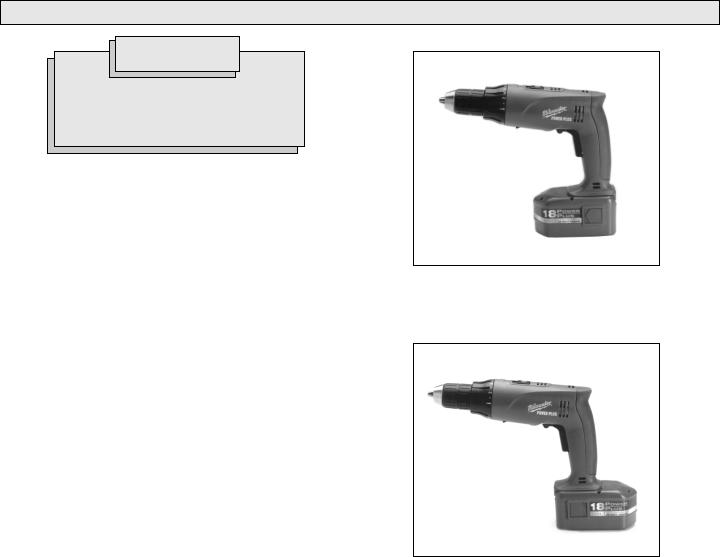
CHARGING AND USING BATTERY PACK
WARNING!
Charge only MILWAUKEE 12, 14.4 and 18 Volt Power Plus battery packs in Power Plus chargers. Other types of batteries may explode causing personal injury and damage.
Charge your battery pack before using your tool for the first time and when your tool no longer performs with the power and torque needed for the job. Full loading capacity of battery pack is only reached after 4 - 5 chargings. Never completely discharge the battery pack. Standard charging time will vary according to the type of charger you use. The charging time will also vary depending on the supply voltage and charge needed. For example, if your battery pack does not require a full charge, charging time will be less.
FOR SPECIFIC CHARGING INSTRUCTIONS, PLEASE READ THE CHARGER INSTRUCTION SHEET SUPPLIED WITH YOUR CHARGER.
Battery packs are affected by temperature. Your battery pack will perform best and have longest life if it is charged when the temperature is between 60°-80°F (15°-27°C). Do not charge in temperatures below 40°F (5°C) or above 105°F (40°C). Under these conditions, capacity will be reduced. See “Maintenance”.
Removing Battery Pack from Tool
Push in the release buttons and remove the battery pack.
Inserting Battery Pack into Tool (Fig. 1 & 2)
Battery pack can be inserted into the tool in two ways.
1.For working in restricted spaces.
Insert the battery pack from the front by pressing in the release buttons and sliding battery pack into the body of the tool (Fig. 1). Insert the battery pack until clamp engages.
Fig. 1
2.For optimum weight distribution and balance.
Insert the battery pack from the back by pressing in the release buttons and sliding the battery pack into the body of the tool (Fig. 2). Insert the battery pack until clamp engages.
Fig. 2
page 4
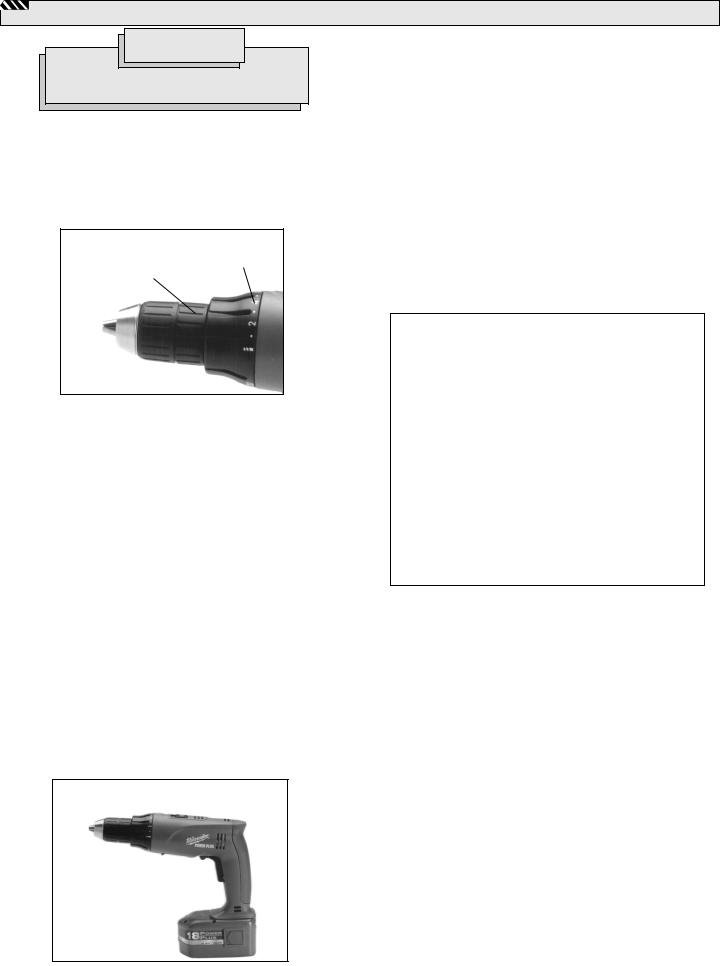
OPERATION
WARNING!
To reduce the risk of injury, wear safety goggles or glasses with side shields.
Using Clutch (Fig. 3)
This tool has an adjustable clutch for driving different types of screws into different materials. When properly adjusted, the clutch will slip at a preset torque to prevent driving the screw too deep and to prevent damage to the screw or tool.
To adjust the clutch, turn the clutch adjusting ring to one of the twenty positions shown on the adjusting ring.
Fig. 3
Position Clutch numbers
adjusting ring
The torque specifications shown here are approximate values obtained with a fully charged battery pack.
|
Torque |
|
|
|
|
Positions 1 - 5 |
0 - 14 in. lbs. |
|
|
|
|
Positions 6 - 10 |
20 - 41 in. lbs. |
|
|
|
|
Positions 11 - 15 |
46 - 60 in. lbs. |
|
|
|
|
Positions 16 - 20 |
65 - 85 in. lbs. |
|
|
|
|
Drill |
|
|
Low |
400 in. lbs. |
|
High |
||
136 in. lbs. |
||
|
||
|
|
NOTE: Because the above settings are only a guide, use a piece of scrap material to test the different clutch positions before driving screws into the workpiece.
Selecting Speed (Fig. 4)
The speed selector is on top of the motor housing. Allow the tool to come to a complete stop before changing speeds. See “Applications” for recommended speeds under various conditions.
1.For Low speed (up to 450 RPM), push the speed selector forward (Position 1).
2.For High speed (up to 1,500 RPM), push the speed selector back (Position 2).
Starting, Stopping & Controlling Speed
1.To start the tool, pull the trigger.
2.To stop the tool, release the trigger and an electric brake stops the tool instantly.
All models feature variable speed control. To vary the speed, simply increase or decrease pressure on the trigger. The further the trigger is pulled, the greater the speed.
Using Control Switch (Fig. 5)
The control switch may be set to three positions: forward, reverse and lock. Due to a lockout mechanism, the control switch can only be adjusted when the ON/OFF switch is not depressed. Always allow the motor to come to a complete stop before using the control switch.
Fig. 5 |
Reverse |
|
|
|
Cat. No. 0521-20 |
Forward
Forward
Trigger
Cat. No. 0522-20
Reverse
Forward (clockwise) rotation, push the control switch to the left position. Check the direction of rotation before use.
Reverse (counter clockwise) rotation, push the control switch to the right position. Check direction of rotation before use.
Locking the trigger, push the control switch to center position. The trigger will not work while the control switch is in the center locked position.
Always lock the trigger or remove the battery pack before performing maintenance, changing accessories, storing the tool and any time the tool is not in use.
Fig. 4 |
Low |
|
High |
|
|
|
|
page 5

Using Keyless Chucks (Fig. 6)
Always remove the battery pack or lock the trigger before inserting or removing bits.
Fig. 6 |
Collar |
|
Sleeve |
1.To open the chuck jaws, hold the collar while turning the sleeve in the counterclockwise direction.
When using drill bits, allow the bit to strike the bottom of the chuck. Center the bit in the chuck jaws and lift it about 1/16" off of the bottom.
When using screwdriver bits, insert the bit far enough for the chuck jaws to grip the hex of the bit.
2.To close the chuck jaws, hold the collar while turning the sleeve in the clockwise direction. Tighten securely.
3.To remove the bit, hold the collar while turning the sleeve in the counterclockwise direction.
APPLICATIONS
WARNING!
To reduce the risk of electric shock, check work area for hidden pipes and wires before drilling or driving screws.
Drilling
Set the clutch adjusting ring to the drill position. Place the bit on the work surface and apply firm pressure before starting. Too much pressure will slow the bit and reduce drilling efficiency. Too little pressure will cause the bit to slide over the work area and dull the point of the bit.
If the tool begins to stall, reduce pressure slightly to allow the bit to regain speed. If the bit binds, reverse the motor to free the bit from the workpiece.
Drilling in Wood, Composition Materials and Plastic
When drilling in wood, composition materials and plastic, start the drill slowly, gradually increasing speed as you drill. When drilling into wood, use wood augers or twist drill bits. Always use sharp bits. When using twist drill bits, pull the bit out of the hole frequently to clear chips from the bit flutes. To reduce the chance of splintering, back work with a piece of scrap wood. Select low speeds for plastics with a low melting point.
Drilling in Metal
When drilling in metal, use high speed steel twist drills or hole saws. Use a center punch to start the hole. Lubricate drill bits with cutting oil when drilling in iron or steel. Use a coolant when drilling in nonferrous metals such as copper, brass or aluminum. Back the material to prevent binding and distortion on breakthrough.
Driving Screws and Nut Running
Drill a pilot hole when driving screws into thick or hard materials. Set the clutch adjusting ring to the proper position and set the speed to low. Use the proper style and size screwdriver bit for the type of screw you are using.
With the screwdriver bit in the screw, place the tip of the screw on the workpiece and apply firm pressure before pulling the trigger. Screws can be removed by reversing the motor.
Overloading
Continuous overloading may cause permanent damage to tool or battery pack.
page 6
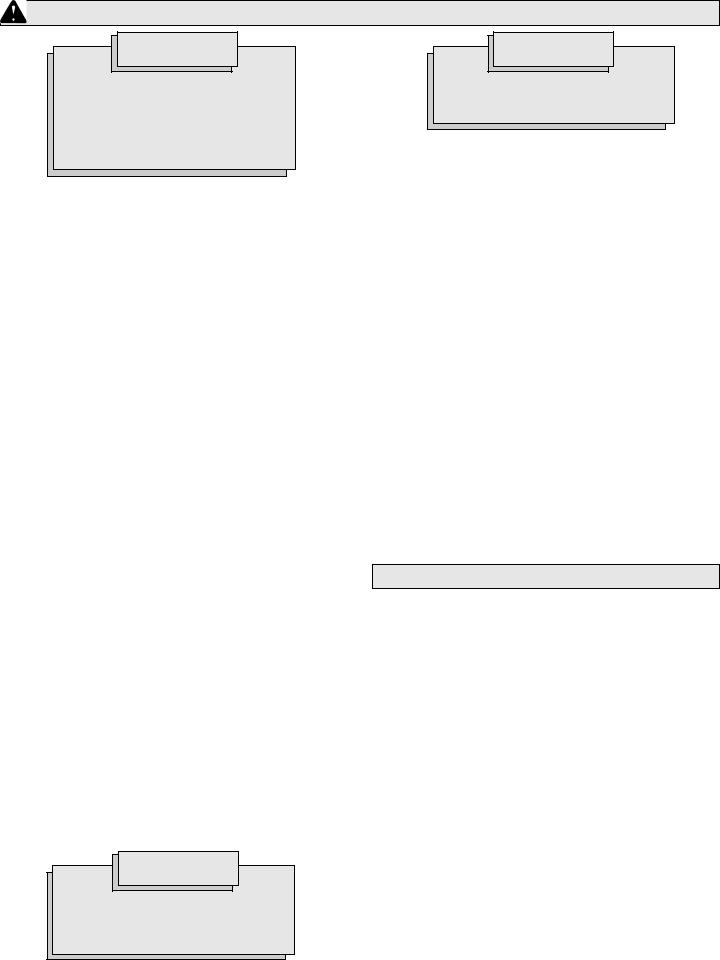
MAINTENANCE
WARNING!
To reduce the risk of personal injury, always unplug the charger and remove the battery pack from the charger or tool before performing any maintenance. Never disassemble the tool, battery pack or charger. Contact a MILWAUKEE service facility for ALL repairs.
Maintaining Tool
Keep your tool, battery pack and charger in good repair by adopting a regular maintenance program. After six months to one year, depending on use, return the tool, battery pack and charger to a MILWAUKEE service facility for:
•Lubrication
•Brush inspection and replacement
•Mechanical inspection and cleaning (gears, spindles, bearings, housing, etc.)
•Electrical inspection (battery pack, charger, motor)
•Testing to assure proper mechanical and electrical operation
If the tool does not start or operate at full power with a fully charged battery pack, clean the contacts on the battery pack. If the tool still does not work properly, return the tool, charger and battery pack to a
MILWAUKEE service facility for repairs.
Maintaining Battery Pack
MILWAUKEE battery packs will operate for many years and/or hundreds of cycles when they are maintained and used according to these instructions.
A battery pack that is stored for six months without being used will discharge itself. Batteries discharge at a rate of about 1% per day. Charge the battery every six months even if it is unused to maximize battery life.
Do not tape the trigger in the “ON” position and leave the tool unattended as this may discharge the battery to a point where it will no longer be able to recharge. Use a MILWAUKEE battery pack only until it no longer performs with the power and torque needed for your application.
Store your battery pack in a cool, dry place. Do not store it where the temperature may exceed 120°F (50°C) such as in a vehicle or metal building during the summer. High temperatures will overheat the battery pack, reducing battery life. If it is stored for several months, the battery pack will gradually lose its charge. One to three cycles of charging and discharging through normal use will restore the capacity of the battery pack.
During the life of the battery pack, the operating time between charges becomes shorter. If the operating time becomes extremely short after a proper charge, the usable life of the battery pack has been reached and it should be replaced.
Cleaning
Clean dust and debris from charger and tool vents. Keep tool handles clean, dry and free of oil or grease. Use only mild soap and a damp cloth to clean the tool, battery pack and charger since certain cleaning agents and solvents are harmful to plastics and other insulated parts. Some of these include gasoline, turpentine, lacquer thinner, paint thinner, chlorinated cleaning solvents, ammonia and household detergents containing ammonia. Never use flammable or combustible solvents around tools.
WARNING!
To reduce the risk of explosion, never burn a battery pack even if it is damaged, dead or completely discharged.
RBRC Battery Recycling Seals
The RBRC™ Battery Recycling Seals (see "Symbology") on your tool battery packs indicate that MILWAUKEE has arranged for the recycling of that battery pack with the Rechargeable Battery Recycling Corporation (RBRC). At the end of your battery pack's useful life, return the battery pack to a MILWAUKEE Branch Office/Service Center or the participating retailer nearest you. For more information, visit the RBRC web site at www.rbrc.org.
Disposing of Nickel-Cadmium Battery Packs
Nickel-Cadmium battery packs are recyclable. Under various state and local laws, it may be illegal to dispose of this battery into the municipal waste stream. Dispose of your battery pack according to federal, state and local regulations.
Repairs
For repairs, return the tool, battery pack and charger to the nearest service center listed on the back cover of this operator's manual.
Battery Pack Warranty
Battery packs for cordless tools are warranted for one year from the date of purchase.
WARRANTY
Every MILWAUKEE product is warranted to be free from defects in material and workmanship. MILWAUKEE will repair or replace any product which examination proves to be defective in material or workmanship.
Limitations: This warranty does not cover: 1) repairs made or attempted by other than MILWAUKEE or MILWAUKEE Authorized Service Station personnel; 2) normal wear and tear; 3) abuse; 4) misuse; 5) improper maintenance; 6) continued use after partial failure; 7) tools that have been modified; or product used with an improper accessory.
Battery Packs are warranted for one (1) year from the date of purchase.
Should a problem develop, return the complete product to any
MILWAUKEE Factory Service Center or MILWAUKEE Authorized Service Station, freight prepaid and insured. If inspection shows the problem is caused by a defect in material or workmanship, all repairs or a replacement will be made at no charge and the product will be returned, transportation prepaid. No other warranty, written or verbal, is authorized.
THE REPAIR AND REPLACEMENT REMEDIES DESCRIBED HEREIN ARE EXCLUSIVE. IN NO EVENT SHALL MILWAUKEE BE LIABLE FOR
ANY INCIDENTAL, SPECIAL, OR CONSEQUENTIAL DAMAGES, INCLUDING LOSS OF PROFITS.
WARNING!
To reduce the risk of personal injury and damage, never immerse your tool, battery pack or charger in liquid or allow a liquid to flow inside them.
THIS WARRANTY IS IN LIEU OF ALL OTHER WARRANTIES, EXPRESSED
OR IMPLIED WHETHER FOR MERCHANTABILITY OR FITNESS FOR
PARTICULAR USE OR PURPOSE.
This warranty gives you specific legal rights. You may also have other rights that vary from state to state. In those states that do not allow the exclusion of implied warranties or limitations of incidental or consequential damages, the above limitations or exclusions may not apply to you.
page 7
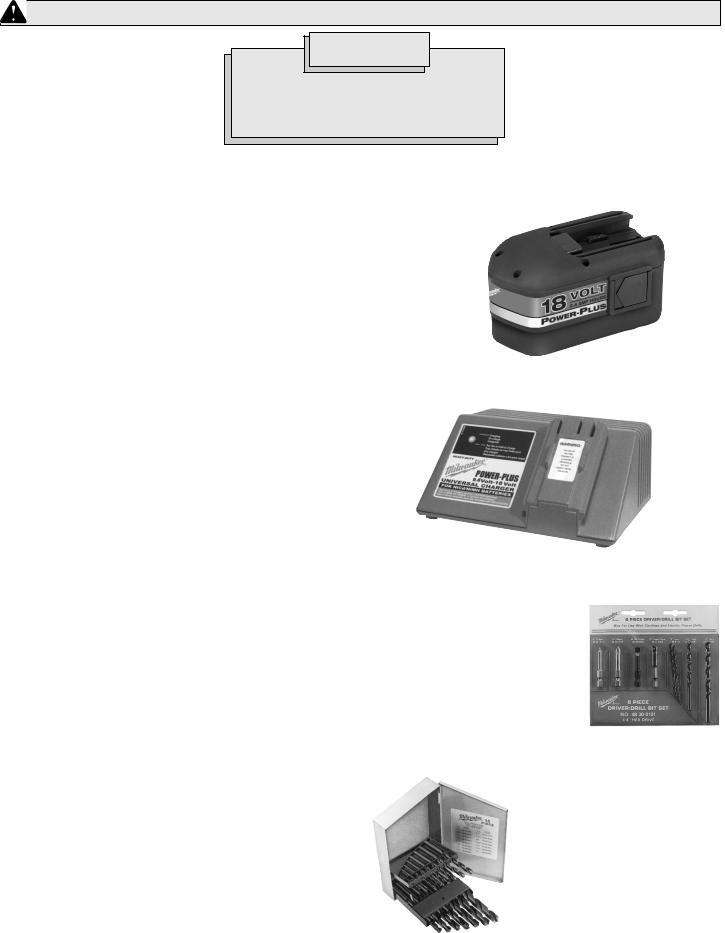
ACCESSORIES
WARNING!
Always remove battery pack before changing or removing accessories. Only use accessories specifically recommended for this tool. Others may be hazardous.
For a complete listing of accessories refer to your MILWAUKEE Electric Tool catalog. To obtain a catalog, contact your local distributor or a service center listed on the back cover of this operator’s manual.
18 Volt Power Plus Battery Packs
Fits MILWAUKEE Charger Cat. No. 48-59-0245.
2.0 Amp-Hours
Cat. No. 48-11-2200
2.4 Amp-Hours
Cat. No. 48-11-2230
Power Plus Chargers 120 Volt
For charging 12-18 Volt Power Plus Battery Packs.
1-Hour Vehicle Charger
Cat. No. 48-59-0186
1-Hour Universal Charger
Cat. No. 48-59-0245
Plastic Carrying Case
Cat. No. 48-55-3015
Driver/Drill Accessory Kit
Cat. No. 48-30-0101
Includes 1/4" socket driver, 6F-7R slotted bit, #1 and #2 Phillips bits, 1/4" and 3/16" twist bits, and two 1/8" twist bits.
Keyless Chuck
Cat. No. 48-66-0365
Rugged nylon housing with rust resistant nickel plated jaws and body. For cordless drills with 1/2" - 20 thread.
Jobbers Length Twist Drill Sets 13 Piece Set
Cat. No. 48-89-0030
Sizes 1/16" to 1/4" by 64ths.
15 Piece Set
Cat. No. 48-89-0020
Sizes 1/16" to 1/2" by 32nds.
21 Piece Set
Cat. No. 48-89-0015
Sizes 1/16" to 3/8" by 64ths.
29 Piece Set
Cat. No. 48-89-0010
Sizes 1/16" to 1/2" by 64ths.
Cat. No. 48-11-
Cat. No. 48-59-0245
Cat. No. 48-30-0101
Cat. No. 48-89-0020
page 8
